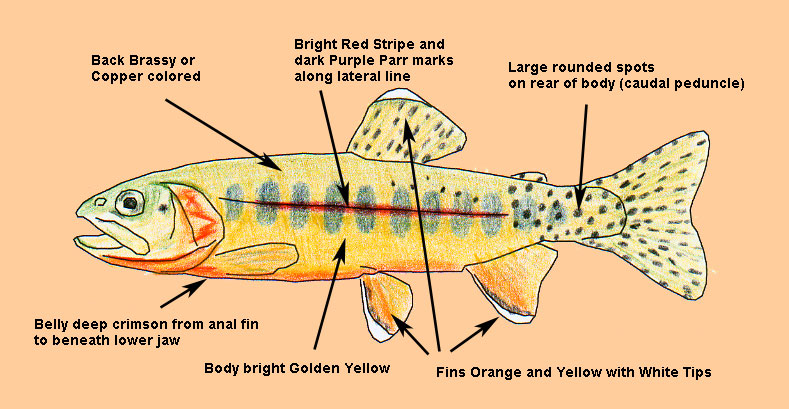Volcano Creek Golden Trout – fit for a golden state

 | |||
| |||
The Volcano Creek Golden trout (Oncorhynchus mykiss aguabonita), also referred to as Golden Creek Golden Trout, has been isolated for tens of thousands of years above impassable barriers in the southern Sierra Nevada. Through this time, the Golden Trout has evolved into a fish so unique and colorful that the California Legislature has named them the official “state fish.” Portions of the Kern River drainage, where golden trout evolved, were spared the glacial action. Glaciers eliminated fish life from higher elevation waters throughout the Sierra Nevada to the north. Although rainbow trout reentered the Kern River drainage following the retreat of glaciers, the presence of waterfalls prevented these fish from mixing with golden trout. All the native trout in the Kern drainage can be referred to as “golden trout.” They are closely related and are classified as a subspecies of their distant relative, the rainbow trout, Oncorhynchus mykiss. True GoldensThose Goldens in the South Fork Kern River and Golden Trout Creek (Oncorhynchus mykiss aguabonita) often are referred to as “true goldens.” They are brilliantly colored and have black spots only on the tail and caudal peduncle. These Goldens have been transplanted to many other lakes and streams of the Sierra Nevada and elsewhere. The South Fork Kern Golden are essentially the same subspecies as the Volcano Creek Golden. However, SF Kern Goldens have some genetic distinctions and can be identified by the spots which sparsely cover the back up to the head. Hybridization ProblemsGenetic purity of the Goldens has been greatly reduced by the planting program of the DFG from Cottonwood Lakes. Over 300 lakes and 700 miles of streams have been planted by this program since 1913. It was discovered in the 1960’s that the Golden Trout Brood stock within the lakes were hybridized. However, examples of hybridization at Cottonwood Lakes has been documented as early as the 1930’s. The brood trout may have become contaminated by the presence of rainbows within the hatchery. Genetic testing has found that the Volcano Creek Goldens in most of Golden Trout Creek and it’s tributaries are pure strains. The South Fork Kern Golden are also threatened by the introductions of rainbows and browns within their habitat. Introduced rainbows hybridize with the Goldens while the Browns compete for habitat and prey upon the smaller Goldens. Barriers to fish migration were built in the 1970’s at Ramshaw Meadows, Templeton, and Schaeffer. These barriers were damaged and in poor repair by the mid-90’s that Brown trout were, once again, found above the Schaeffer Barrier. Repairs to the barriers have been made. However, there are currently browns found above the Templeton Barriers. Genetic testing of the South Fork Kern Goldens above the Templeton Barrier have still indicate a hybridized strain. Coloration TheoriesIt is commonly believed the Golden Trout developed their bright red and yellow colors in response to their natural environment. The substrate of many of their native streams have granitic stones stained in light yellow and reddish hues of volcanic origin. Some speculate the goldens adapted to this background color. Another theory is that ultraviolet light may have had an influence. Fish in the shallow, exposed, high elevation streams are more vulnerable to this solar light source than those in more shaded waters at lower elevations. Usually, goldens found in the exposed high UV light are more brilliantly colored. Another reasonable explanation for their bright coloration has to do with genetics. Because of their short growing season, golden trout in high elevation habitats spawn as early as snow-melt conditions allow. The very cold temperatures during early egg development could deactivate certain enzymes. These enzymes would digest the color pigments of material in the trout’s diet. If not metabolized, these red and yellow pigments could become deposited in the skin of the trout. Meadow habitats, with greater amounts of vegetation close to the water (and available in the food chain), usually produce more brilliantly colored golden trout. A combination of those influences are probably responsible for the bright coloration of golden trout. Distinguishing Characteristics:The Volcano Creek Golden can be distinguished by its bright golden body. The back has a brassy or copper coloration. A bright red stripe goes through the center of the body with dark purple parr marks along the lateral line. The belly is usually a deep crimson and the pelvic, anal , and dorsal fins are orange and yellow with white tips. | |||

